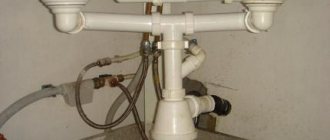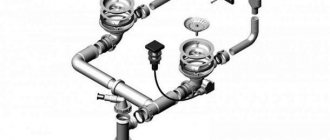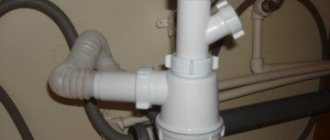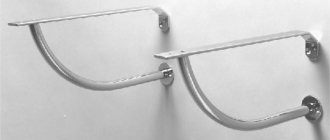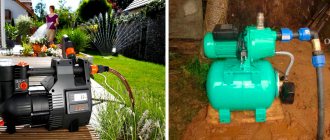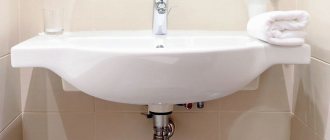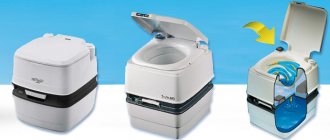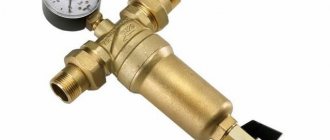Siphon device
The sink siphon is a tube that ensures unhindered drainage and at the same time prevents the spread of sewer odor into the external environment.
The main function of the siphon is ensured by a special design - bending of the tube, due to which a water seal (water plug) is formed. Its main task is to ensure the tightness of the room from sewage odors, preventing them from spreading into the kitchen or bathroom.
Siphons, like all components of the drain system, are subject to natural wear and tear. At the same time, there are often unforeseen situations that require an immediate response - the pouring of a large amount of water from the system can cause inconvenience to both you and your neighbors. Therefore, it will not be superfluous to know how the siphon works, what the principle of its operation is. This will help you not to get confused in an emergency situation when you need to wait for specialized help for some time.
DIY installation
Before you begin installing the siphon, it is necessary to carry out some preparatory work. The first step, of course, is to get rid of the old siphon. After it is dismantled, try to clean the sewer pipe at least a little from any accumulation of dirt. This will help you avoid blockages in the future.
Seal the groove of the siphon body with an o-ring gasket and tighten the parts. Attach the coupling nut to the outlet pipe and seal with a cone-shaped gasket. Insert the outlet pipe into the groove of the body and tighten the nut, but not all the way, otherwise the siphon will not work. Attach the outlet to the side pipe and secure the connection with a coupling nut, having previously sealed it with a flat gasket. Place a protective mesh in the sink drain hole and a pipe on the other side. Don't forget to seal the connection with a rubber gasket! Secure the structure by screwing the clamping screw into the grille.
The best posts
- Base for DIY bracelets made of plastic
- Women's sweater with knitting patterns: how to knit with photos and videos
- Frame for a hammock: types and order of construction
- Do-it-yourself wooden bunk bed: making
- Ideas for crafts from autumn flowers (56 photos)
- DIY Japanese-style bed: drawing and processing of blanks
- Living room ceiling design trends
- Wooden wallpaper: wood effect, for walls in the interior, photo with a pattern in a country house, stickers, image imitation, boards, combination, video
Sink siphon design
The structure of the siphon is approximately the same for all devices, but depending on the model and manufacturer it may differ in some features.
A standard sink siphon consists of:
- protective mesh. Its purpose is to prevent the entry of large particles of debris and thereby prevent clogging of the system. This is the so-called primary filtration system. It is installed with a unit that is attached to the sink;
- overflow pipe. This is a system that prevents the sink or bathroom from overflowing with water. It is attached to the outlet pipe;
- rubber gaskets that ensure tight connections between siphon elements;
- outlet pipe;
- a connecting screw that fastens the siphon parts together;
- the siphon itself;
- sewerage outlet.
Choice
So, the choice of siphon depends on many different factors:
- The type of sink to which the siphon is connected. If the sink is of such a model that the space under it is open to the eye, then it is worth purchasing a metal siphon. The plastic siphon does not look so good, so it is better to install it only under closed sink models.
- Availability of free space in the bathroom. If the bathroom is small and every piece of free space counts, then buy a corrugated plastic siphon. It takes up very little space and allows, for example, to install a washing machine under the sink.
- The room in which the siphon will be used. If you choose a siphon for a country house where there is no water supply in winter, a dry type drain siphon will suit you.
- Siphon capacity . It should be higher, the more household appliances connected to it and the greater the water pressure in the tap.
- Width of the siphon section. The throughput of the siphon directly depends on it.
- Siphon price. Metal models tend to be more expensive.
Related article: Sample application for balcony repair
Classification of siphons
The modern market offers many types of siphons, which differ in shape, size and materials from which they are made. The following classification will help you understand what siphons for sinks are.
According to their design, siphons are divided into:
Bottle
The most common type. In its flask, which looks like a bottle, which is where its name actually comes from, water accumulates, which blocks the flow of waste fumes into the room. These siphons can be square, rectangular or round in shape.
Pros:
- may have one or two outlets - very convenient if you need to connect several devices to it, for example a washbasin and a washing machine;
- versatility - suitable for various types of plumbing fittings;
- You don’t have to be afraid of dropping anything valuable into such a siphon - it remains at the bottom of the flask and is not washed off into the drain. It can be easily obtained when disassembling the siphon;
- easy to clean - dirt on the internal surfaces of the siphon can be easily removed using special products.
Minuses:
- The device is quite large and requires a lot of space to install it.
Corrugated
A simple siphon, which is a flexible corrugated tube that is attached to the sink at one end and to the sewer pipe at the other. Using clamps you can give the required bend with a water seal in the middle.
Pros:
- its installation does not require a lot of space under the plumbing fixture;
- easy to install and easy to maintain;
- The flexibility of the tube allows you to easily change its length.
Minuses:
- susceptible to temperature influences, especially when it comes to boiling water;
- high clogging - a lot of fat and dirt accumulate in the folds of the corrugation, so the siphon itself or its parts have to be changed quite often.
Tubular
Also a fairly simple siphon, it is an S- or U-shaped tube.
Pros:
- easy to operate - if it is necessary to remove blockages or contamination, dismantling the curved part of the siphon does not require much effort;
- less susceptible to blockages due to its type of device.
Minuses:
- a water seal is formed in a small depression, so if the sink is not used very often, water evaporation may be observed, accompanied by a fetid waste odor;
- To clean such a siphon, it must be completely removed.
Depending on the installation, the following siphons are distinguished:
Flat
This is a type of bottle siphon. It is distinguished by its compact size and flat flask. They are used when there is a shortage of space for installation, for example, when a sink needs to be placed above a washing machine.
Pros:
- compact size allows installation in difficult-to-install places, saving already limited space;
- easy to clean just like any bottle model.
Minuses:
- none.
Hidden
Similar to bottle siphons, but the bulb is installed into the wall. This is quite inconvenient to use, although it saves space under the sink.
Open
The most convenient model due to ease of installation and low maintenance.
Siphons can be equipped with additional functionality:
- Overflow:
flood warning system. There is an internal overflow, as well as an overflow with a built-in bottom valve, which does not require another hole in the plumbing fixture;
- Food waste grinding system:
a good alternative to trash cans, prevents blockages in pipes.
Classification of siphons according to the operating features of the closing plugs:
- Manual.
They are equipped with a drain lid, separate or attached with a chain;
- Semi-automatic.
A more advanced design, its closing and opening is carried out by turning the handle, which is connected to the drain cover using a cable. There is no need to wet your hands to drain the water.
- Automatic.
Allows you to control the water level in a plumbing fixture using automation.
They come with a handle for opening the plug
, which is located on the overflow hole compartment, or
with a click-clack system
: the drain plug is moved by pressing with your hand or foot.
Depending on the material used, the following types of siphons for sinks are distinguished:
- Plastic:
they are characterized by simple designs and fewer connections. In their production, polyethylene is sometimes used, but most often polypropylene is used. It is more resistant to boiling water. - Metal:
They are more expensive than plastic, but they have a longer service life. For the manufacture of such siphons, copper alloys are most often used: brass and bronze, as well as stainless steel. Due to their high cost, they cannot boast of very wide application.
Principle of operation
Over time, the designs of all plumbing fixtures change, and the same applies to the siphon. However, no matter what design it acquires, the principle of operation of the siphon remains unchanged. The simplest diagram can be represented as follows:
- water enters the flask through the sink drain;
- passes through several pipes;
- some water remains in the sump;
- the rest of the water enters the sewer, passing through the outlet pipe;
- The water that settles in the sump creates a blockage, resulting in an unpleasant odor remaining in the sewer.
Siphon disassembled
If the device is installed correctly, the principle of operation of the siphon is not affected. There is an exception in which the smell may spread throughout the room. Here we are talking about the long absence of the owners of the apartment, when the sinks and bathtub are not used for a long time. In this case, an odor may appear in the room, but it can be easily eliminated by running water.
It is worth saying that this product consists of several elements, which are connected to each other by cone-shaped gasket sleeves. It is these gaskets that play an important role in the safety and performance of the device. It is very important that the sleeves have sufficient plasticity. Poor quality gaskets can lead to sudden failure of the device, which will require repair or replacement of the entire siphon.
Buy a siphon in Bataysk or Rostov
Our store presents the best and most practical models of siphons, the benefits of which have long been appreciated by our regular customers. We have been selling siphons and components both in Rostov-on-Don and Bataysk for several years.
We will help you choose the best device that will become a reliable part of the drainage system. Our siphons are your confidence in the durability of one of the most important communication systems in your home. You can buy a siphon at the best price in the Rostov region on our website.
Performance characteristics
Siphons for carbonating water are manufactured in accordance with regulatory requirements. Parts in contact with carbon dioxide are made of corrosion-resistant material or have a protective coating.
Siphons are manufactured in accordance with regulatory requirements
When you press the lever, a force of 24.5 N is created. The valve opens as soon as the pressure inside the siphon reaches 1.8 + 0.4 MPa. In this case, the head and body of the device are able to withstand a pressure of at least 2.5 MPa.
The containers are designed for high pressure
